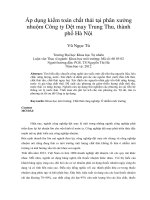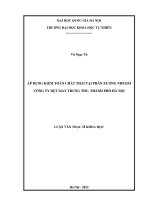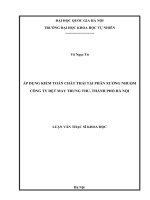kiem toan chat thai
Bạn đang xem bản rút gọn của tài liệu. Xem và tải ngay bản đầy đủ của tài liệu tại đây (162.87 KB, 43 trang )
<span class='text_page_counter'>(1)</span><div class='page_container' data-page=1>
<b>Environmental Technology </b>
<b>Environmental Technology </b>
<b>Assessment</b>
<b>Assessment</b>
PGS. TS. Nguyen Thi Ha
PGS. TS. Nguyen Thi Ha
FES- HUS
</div>
<span class='text_page_counter'>(2)</span><div class='page_container' data-page=2>
Objectives
Objectives
– Understand the principles of economically viable
and environmentally sound waste collection;
recycling; and treatment
– Evaluate the environmental impacts of process
technologies, especially those related to waste
collection; recycling; and treatment;
– Be capable of applying the methodology
described in the Environmental Technology
</div>
<span class='text_page_counter'>(3)</span><div class='page_container' data-page=3>
<b>Goals of EnTA</b>
<b>Goals of EnTA</b>
– describe the proposed technology,
available alternatives, their
requirement and operating
environment;
</div>
<span class='text_page_counter'>(4)</span><div class='page_container' data-page=4>
<b>Goals of EnTA</b>
<b>Goals of EnTA</b>
– characterise the environmental
impacts (on the human health and
safety, on the natural environment,
including non-renewable resources,
on the community) these pressures
may cause, and
</div>
<span class='text_page_counter'>(5)</span><div class='page_container' data-page=5>
<b>EnTA characteristics</b>
<b>EnTA characteristics</b>
– EnTA is a qualitative tool that minimises
the need for detailed technical data;
– EnTA is designed to facilitate
multi-stakeholder dialogue leading to consensus
decision making;
– EnTA is intended to be used to prevent
</div>
<span class='text_page_counter'>(6)</span><div class='page_container' data-page=6>
<b>EnTA characteristics</b>
<b>EnTA characteristics</b>
– EnTA is multidisciplinary – technical,
economic and environmental conditions
and processes can often be complex;
therefore many different skills are required
in assembling, combining, interpreting,
</div>
<span class='text_page_counter'>(7)</span><div class='page_container' data-page=7>
<b>EnTA characteristics</b>
<b>EnTA characteristics</b>
– EnTA involves simplifying both the
relationship between the technology and
its environment, and the consequences of
those interactions; and
– EnTA examines the environmental effects
of the entire technological system including
the resources used and the waste
</div>
<span class='text_page_counter'>(8)</span><div class='page_container' data-page=8>
<b>Three core values of </b>
<b>Three core values of </b>
<b>environmental technology</b>
<b>environmental technology</b>
<b>assessment</b>
<b>assessment</b>
i) environmental sustainability, by building in
environmental safeguards;
ii) integrity, by having the assessments
conform to agreed standards; and
</div>
<span class='text_page_counter'>(9)</span><div class='page_container' data-page=9>
Business benefits from EnTA
Business benefits from EnTA
• <sub>avoiding pollution, regulatory problems, legal </sub>
and clean up costs;
• <sub>improving the environmental profile of the </sub>
company within the community and the
marketplace;
• <sub>reducing maintenance costs and </sub>
• <sub>improving overall performance; lowering </sub>
</div>
<span class='text_page_counter'>(10)</span><div class='page_container' data-page=10>
Government benefits from EnTA
Government benefits from EnTA
• <sub>reducing health care costs from industrial </sub>
accidents and emissions;
• avoiding high costs for pollutant spills;
planning ahead and
• <sub>better managing the environment; </sub>
</div>
<span class='text_page_counter'>(11)</span><div class='page_container' data-page=11>
<b>General public benefits from EnTA</b>
<b>General public benefits from EnTA</b>
• <sub>obtaining higher quality of life, fewer work </sub>
related illnesses and injuries;
• reducing life risk from industrial pollutants;
• <sub>maintaining social and cultural values; </sub>
ensuring protection of the environment;
</div>
<span class='text_page_counter'>(12)</span><div class='page_container' data-page=12>
<b>EnTA involves</b>
<b>EnTA involves</b>
Assembling, combining, interpreting and
communicating existing knowledge from
diverse sciences, technology and policy
related disciplines for ultimate use by
</div>
<span class='text_page_counter'>(13)</span><div class='page_container' data-page=13>
<b>The role of environmental </b>
<b>The role of environmental </b>
<b>technology assessment in </b>
<b>technology assessment in </b>
<b> environmental improvement</b>
<b> environmental improvement</b>
i) recognizing that the “environment” is wider
than ecosystems and living resources, for
it includes economic, social, aesthetic and
cultural conditions and amenity values;
ii) adopting proactive management
approaches that emphazise problem
</div>
<span class='text_page_counter'>(14)</span><div class='page_container' data-page=14>
<b>The role of environmental </b>
<b>The role of environmental </b>
<b>technology assessment in </b>
<b>technology assessment in </b>
<b> environmental improvement</b>
<b> environmental improvement</b>
iii) adopting an adaptive management
approach due to uncertainties in initial
identification of potentially adverse
environmental impacts;
iv) considering the wider technological
system, rather than the technology itself,
in isolation; and
</div>
<span class='text_page_counter'>(15)</span><div class='page_container' data-page=15>
The relationship between EIA and
EnTA
• <sub>The EIA is obligatory while EnTA is </sub>
voluntary.
• EnTA can best be used to prevent the
enterprise from reaching the stage of doing
an EIA on an unfeasible technology or
other proposal
</div>
<span class='text_page_counter'>(16)</span><div class='page_container' data-page=16>
Challenge for EnTA
Challenge for EnTA
• <sub>In its present form it does not give rise to a </sub>
framework for developing a strategy for
improving the environmental outcomes
associated with the activities of the
</div>
<span class='text_page_counter'>(17)</span><div class='page_container' data-page=17>
Challenge for EnTA
Challenge for EnTA
• <sub>The field trip was considered to be an </sub>
excellent opportunity to evaluate a real
world activity, rather than engage in EnTA
on a theoretical basis.
• <sub>EnTA is considered to be useful at the </sub>
</div>
<span class='text_page_counter'>(18)</span><div class='page_container' data-page=18>
<b>EnTA as an Environmental </b>
<b>Management Tool</b>
• <sub>EnTA is viewed as a “scoping tool”, to be </sub>
used at the “idea stage”, rather than after
development of a formal or full project
proposal.
• <sub>EnTA is largely qualitative. This has </sub>
advantages in that it identifies the data
required to complete the assessment and is
more likely to be used than are assessment
methods that require large amounts of
</div>
<span class='text_page_counter'>(19)</span><div class='page_container' data-page=19>
<b>EnTA as an Environmental </b>
<b>Management Tool</b>
• <sub>EnTA is an instrument that encourages a </sub>
</div>
<span class='text_page_counter'>(20)</span><div class='page_container' data-page=20>
<b>EnTA as an Environmental </b>
<b>Management Tool</b>
• <sub>EnTA is an appropriate, proactive </sub>
environmental management tool that
facilitates a multidisciplinary and
multiEnvironmental sector approach to
environmental management. While it is
useful in simplifying the environmental
management issues and options of
</div>
<span class='text_page_counter'>(21)</span><div class='page_container' data-page=21>
<b>EnTA as an Environmental </b>
<b>Management Tool</b>
• <sub>EnTA also fosters a comprehensive and </sub>
integrated approach, especially with regard
to the implications of the technology
system.
• <sub>EnTA identifies if more sophisticated </sub>
assessment tools, such as environmental
risk assessment and cost-benefit analysis,
need be used to ensure that the
</div>
<span class='text_page_counter'>(22)</span><div class='page_container' data-page=22>
<b>EnTA as an Environmental </b>
<b>Management Tool</b>
• <sub>EnTA is not a “recipe” that has to be </sub>
followed on a rigorous basis – rather the
procedures can be modified and
supplemented, and they should evolve in
response to the process itself, and
</div>
<span class='text_page_counter'>(23)</span><div class='page_container' data-page=23>
<b>EnTA as an Environmental </b>
<b>Management Tool</b>
• <sub>EnTA is a useful and appropriate tool to </sub>
facilitate dialogue between multiple
stakeholders and to gain a comprehensive
appreciation of a situation; it is very good at
enhancing understanding and raising
</div>
<span class='text_page_counter'>(24)</span><div class='page_container' data-page=24>
<b>EnTA as an Environmental </b>
<b>Management Tool</b>
• <sub>EnTA can aid in the identification and </sub>
understanding of the issues, as a
prerequisite to an effective multistakeholder
dialogue, with the aim of bringing all
stakeholders to a common level of
understanding
</div>
<span class='text_page_counter'>(25)</span><div class='page_container' data-page=25>
<b>EnTA as an Environmental </b>
<b>Management Tool</b>
• Most assessments end up as (subjective)
judgements even if they endeavour to be
objective; but there may be value in weighting
some of the categories so that there is more
benefit from aggregation of the impacts;
• The subjective character of EnTA is elevated by
its position as a tool in a multi-stakeholder
process, with a focus on education and a
</div>
<span class='text_page_counter'>(26)</span><div class='page_container' data-page=26>
<b>EnTA as an Environmental </b>
<b>Management Tool</b>
• EnTA is subjective, and there is a need to either
clarify the meaning of such categories as “high,
medium and low”, or relate the terms to an
agreed base line;
• <sub>As a tool for informing, generating discussion </sub>
and advising multiple stakeholders, the
subjectivity of EnTA is not a problem;
• A key to the success of EnTA is harmonizing
</div>
<span class='text_page_counter'>(27)</span><div class='page_container' data-page=27>
<b>EnTA as an Environmental </b>
<b>Management Tool</b>
• There are different roles for EnTA, depending on
a country’s level of development and the status
of environmental management in that country;
• <sub>EnTA can also be used within a company, or at </sub>
national level to facilitate a dialogue by raising
awareness and identifying key issues;
• <sub>NGOs and regulators saw EnTA as an excellent </sub>
</div>
<span class='text_page_counter'>(28)</span><div class='page_container' data-page=28>
<b>EnTA as an Environmental </b>
<b>Management Tool</b>
In the ideal application of EnTA, one would need
all the lifecycle costs reflected in prices (i.e.
internalized) and all decisions could then be
made on the basis of a cost-benefit analysis; but
there are departures from the ideal:
i) all costs are not internalised;
ii) currently most technology systems are
based on not all costs being internalised – to do
so would make many of the present systems
uneconomic and redundant and;
</div>
<span class='text_page_counter'>(29)</span><div class='page_container' data-page=29>
<b>EnTA as an Environmental </b>
<b>Management Tool</b>
• <sub>EnTA demonstrated how it can be used to </sub>
change a viewpoint from seeing something
as a waste to viewing it as a product;
• <sub>Should EnTA be compulsory/binding or </sub>
</div>
<span class='text_page_counter'>(30)</span><div class='page_container' data-page=30>
<b>EnTA as an Environmental </b>
<b>Management Tool</b>
• EIA is not working in many Asian countries and
where it is working, it is a specialized tool in the
hands of a few regulators and consultants –
while EIA may allow industry to meet its
regulatory requirements, only EnTA can ensure
inputs from all stakeholders, and only EnTA
requires all options to be considered; and
• <sub>A key concern is to identify what is wrong with </sub>
</div>
<span class='text_page_counter'>(31)</span><div class='page_container' data-page=31>
<b>The Methods and Practices of </b>
<b>EnTA</b>
• <sub>The start of any EnTA requires the </sub>
evaluation team to establish the
assessment framework, goals,
commitment, and resources available.
• <sub>In this phase </sub><b><sub>the tasks, responsibilities, </sub></b>
</div>
<span class='text_page_counter'>(32)</span><div class='page_container' data-page=32></div>
<span class='text_page_counter'>(33)</span><div class='page_container' data-page=33>
Step 1
Step 1
•
<sub>Describing the proposed technology </sub>
by defining the technology
•
<sub>Being considered, identifying the goals </sub>
the technology is intended to satisfy,
•
<sub>Identifying the stakeholders and by </sub>
</div>
<span class='text_page_counter'>(34)</span><div class='page_container' data-page=34>
Step 2
Step 2
• Identifying the raw materials, land, energy,
labour, infrastructure and supporting
technologies required for the technology to
operate, and the wastes and hazardous
products produced by the technology.
• Characterizing the potential environmental and
related impacts associated with each of these
components.
• <sub>Considering the inputs and outputs over the </sub>
</div>
<span class='text_page_counter'>(35)</span><div class='page_container' data-page=35>
Step 3
Step 3
• <sub>Leading to an overall assessment of the </sub>
environmental risks.
• Identifying information gaps and
uncertainties
• <sub>Contributing to the decision as to whether </sub>
</div>
<span class='text_page_counter'>(36)</span><div class='page_container' data-page=36>
Step 4
Step 4
• <sub>An important part of EnTA is consideration </sub>
of alternative technologies that may also
achieve the same goals as the proposed
technology.
• <sub>Other technologies are considered in, in </sub>
</div>
<span class='text_page_counter'>(37)</span><div class='page_container' data-page=37>
Step
Step
5
<sub>5</sub>
• <sub>The fifth step is to combine all of the </sub>
previously acquired information in order to
reach a consensus as to the suitability of
the proposed technology, and any
alternatives.
</div>
<span class='text_page_counter'>(38)</span><div class='page_container' data-page=38>
Follow-up activities
Follow-up activities
• <sub>reporting the findings and </sub>
recommendations to the interested parties.
• monitoring of the use of the findings and
identifying where subsequent
assessments might be strengthened.
</div>
<span class='text_page_counter'>(39)</span><div class='page_container' data-page=39>
Notes
Notes
• In many instances the various steps in the
technology evaluation can be undertaken
simultaneously or in a different order,
depending upon the timeframe and resources
available to the assessment team.
• EnTA can be an incremental and circular
process (as Figure), continually incorporating
new information, understanding and
</div>
<span class='text_page_counter'>(40)</span><div class='page_container' data-page=40></div>
<span class='text_page_counter'>(41)</span><div class='page_container' data-page=41>
Aspects of action plans
• <sub>EnTA will be further evaluated and applied </sub>
in the domestic situation, with different
applications and approaches – e.g.
treatments, adaptation, innovation;
• <sub> Multi-sector training and consultation will </sub>
</div>
<span class='text_page_counter'>(42)</span><div class='page_container' data-page=42>
Aspects of action plans
• <sub>The policy environment for the </sub>
implementation of EnTA will be developed
in the home country; and
• <sub>The tool will be refined (e.g. improve </sub>
</div>
<span class='text_page_counter'>(43)</span><div class='page_container' data-page=43>
<b>Preparation of Personal Action </b>
<b>Plans</b>
• Actions that can be undertaken without
assistance in addition to that already
available in the course of current
employment; and
• <sub>Actions that can be undertaken only if </sub>
</div>
<!--links-->









